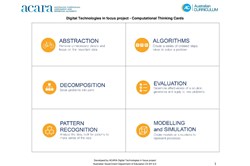Lesson ideas
These lesson ideas can be used to teach the key concepts of the Digital Technologies curriculum.
Additional details
| Year band(s) | Foundation, 1-2, 3-4, 5-6, 7-8, 9-10 |
|---|---|
| Content type | Lesson ideas |
| Format | Web page |
| Organisation | ESA |
| Copyright | Creative Commons Attribution 4.0, unless otherwise indicated. |
Related resources
-

eSafety Commissioner: Video and resource library
Online safety resources for secondary schools supported by lesson plans and mulitimedia resources. Use the filters to find tailored resources suitable for your classroom needs.
-

Classroom ideas F-10: Aboriginal and Torres Strait Islander connections to Digital Technologies
This resource provides examples of ways Aboriginal and Torres Strait Islander Histories and Cultures can be integrated into Digital Technologies. Examples include 'classification and sorting data' and 'designing solutions'.
-

Computational thinking poster
A poster/infographic that gives a brief overview of the concepts related to computational thinking.
-

Computational thinking cut out cards
A set of printable cards that give a definition of six aspects of computational thinking.
